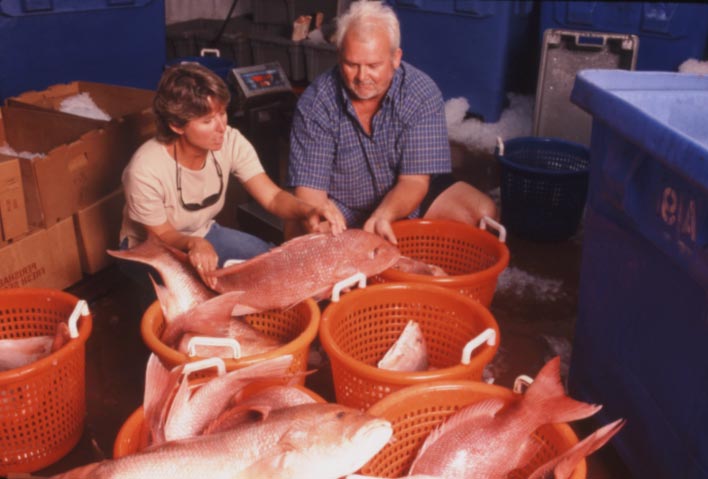New Red Snapper IFQ Report Raises Hope for Other Troubled Fisheries

No matter how many scientific studies emerge confirming the benefits of catch shares, you always have opponents who say catch shares may work in “theory,” but still have doubts about their real-life application.
However, it’s hard to refute on-the-ground, tangible results, like those shown down in the Gulf of Mexico.
This week the National Marine Fisheries Service (NMFS) released the 2008 annual report reviewing the progress of its Gulf of Mexico commercial red snapper individual fishing quota program (IFQ), which is a type of catch share.
The report shows continued success for red snapper two years into the program, and provides additional support for implementing IFQs to rebuild other troubled fisheries.
The report’s conservation highlights include:
- Overfishing is being reversed in the commercial fishery.
- Fishermen have caught under less than allotment by 2.5-4.0 percent in the past two years.
- Fishermen cut their ratio of wasted fish to fish taken to the docks by almost 70 percent. (Before the IFQ, for every fish a fisherman kept, he threw one back dead. Now, fishermen only throw one back for every three to four that they keep.)
The report’s economic highlights include:
- Long season closures and extreme market swings have been eliminated.
- With year-round fishing, fishermen bring high quality fish to the dock when consumer demand is high, helping their businesses remain profitable.
- The price fishermen pay for quota, the long-term privilege to catch red snapper, rose by 37 percent, reflecting optimism for a healthy fishery and a commitment to conservation.
With the conservation gains seen in the commercial red snapper fishery in just a few years, we are optimistic that rebuilding is getting underway and the payoff might be a rising catch limit in the near future. The Gulf of Mexico Fishery Management Council is on the right track by considering IFQs and other catch share plans for many of its other commercial and sport fisheries that are in dire need of better management.
The NMFS report concludes that the commercial red snapper fishery is on the right track, and it identifies a few ways that it can be improved. For example, the mislabeling of fish needs to be stopped, and better ways are needed to count dead fish that some vessels continue to throw overboard, especially off of the Florida peninsula coast.











4 Comments
A very interesting overview but way off track.The Red Snapper stocks have rebounded on the eastern gulf over the last 20 years and red snapper population is better today than in the last fourty years (fact)Real -life application three factors.#1 becouse of federal law comerical harvesting has been all but elimated.#2 recreational bag limmits are in order.#3 And most inportment the water quilty has gotten some what better.Myth(Fishermen cut their ratio of wasted fish to fish taken to the docks by almost 70 percent. (Before the IFQ, for every fish a fisherman kept, he threw one back dead. Now, fishermen only throw one back for every three to four that they keep.)Truth of the matter had no wast rotio prier to Gulf Councile admenment#1 wast was totally the work of the Gulf Councile.They in there mismangement created by catch (WAST)size limets.closed seasons for diffrent offshore fishery’s greated wast!
You make a good point about fish size limits creating waste. Fortunately, under catch shares fishermen have a pre-determined amount of fish they can catch and size limits aren’t as necessary. Under the commercial red snapper individual fishing quota (IFQ) program, the red snapper size limit was reduced from 15” to 13”, which allowed fishermen to keep almost everything they caught. This significantly reduced waste, which was good for fish populations, and made each fishing trip more efficient.
Pam I do agree IFQ is a much better way of managment.But who is entitled to IFQ? The answer is it’s based on previse landings.Recored by NMFS so the more you landed or killed the more you get to land or kill right? Well that makes great sense.We purchased reef permits but chose not to fish at this time but to insure my son Levi the right to be a fourth generation red snapper/grouper fishermen and leave the fishery rebuild.So now we pay the price more sound fishmangment,We still have documented landing records dating back to the early 50’s a few million pounds of them.But were not quilfied!My fish managment plan restrict the fishery to IFQ and gear restriction to veritical line and i few strong and proud will surive the test of time!
the commercial red snapper fishery is on the right track, and it identifies a few ways that it can be improved,sounds great.